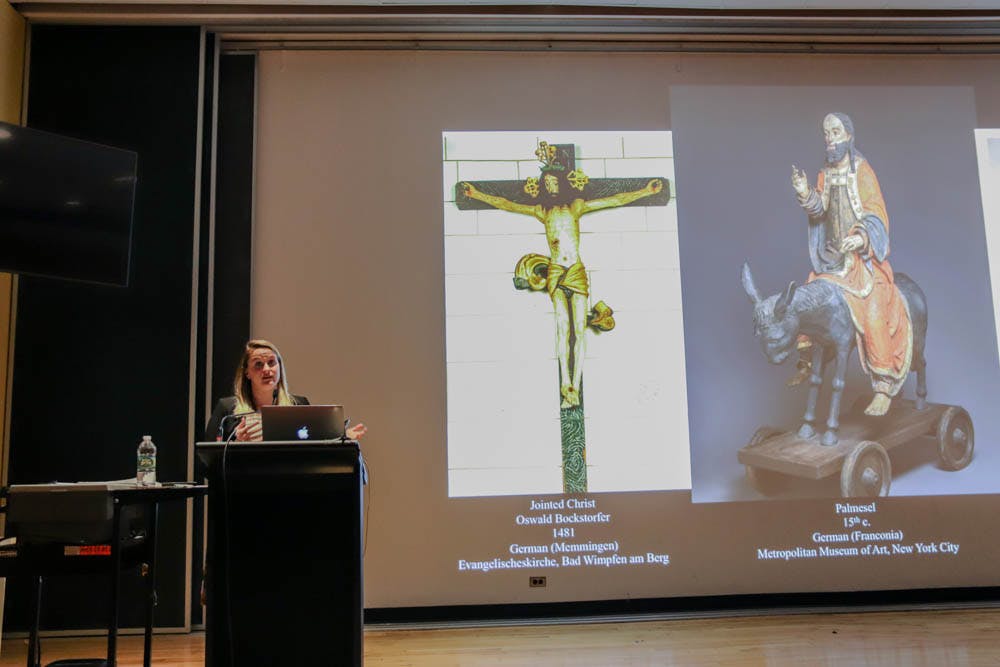The worlds of medieval Christianity and science fiction collided in a lecture by Michelle Oing ’07 last Thursday evening.
During the event, titled “The Medieval Cyborg: Performing Objects in the Late Middle Ages,” Oing examined the usage of puppets in medieval liturgy and compared them to cyborgs, or fictious figures that are part-man part-machine. She argued that both prompt questions about the relationship between mind, body and the essence of humanity.
Oing excavated humanity’s relationships with puppets and with cyborgs, saying that “through their hybridity, through their productive play with boundaries and binaries, both the puppet and the cyborg ask: what makes the human, human?” Cyborgs, she continued, answer this question through “the logic of fusion,” unifying the machine and the organism.
Puppets, on the other hand, respond with “the logic of negotiation,” investigating the relationship between object and human. Oing argued that both cyborgs and puppets offer a “way out of the world,” but that puppets in medieval Christianity did so through the collective, not the individual. She finished by stating, “the puppet was neither goddess nor cyborg, but rather a powerful means of transcendence.”
To further explore the dynamic between humans and puppets, Oing referenced the “roraffe,” a movable sculpture in the dress of a peasant that has stood on the wall of the Strasbourg Cathedral in Strasbourg, France since 1385. The puppet has a compartment behind it for an operator to move its mouth, unlike all of the other sculptures in the cathedral, which are inoperable.
Oing explained that the only evidence of the puppet’s usage in liturgy comes from those who disapproved of it, citing a letter complaining that the puppet yelled foul language and taunted at church-goers during mass.
She challenged the audience to put away preconceived notions about puppets as play toys, defining them as “object(s) which in both appearance and movement imitate a life-form … in the presence of an audience, which receives input from a human operator, which thus produces its action.”
Oing explained that many of her experiences while an undergraduate at Brown inspired the subject of her dissertation at Yale; her work examines a range of figural objects to highlight nuances of medieval and early modern conceptions of mimesis, which refers to the representation of the real world in art and literature. She spoke fondly of her classes in art history and religious studies and her participation in theater. “My Brown education gave me a lot of tools to think with, not just facts and figures. All of my professors were somehow dealing with larger meta-questions,” Oing said, describing how she hopes that her work is able to incorporate ancient questions about humanity in relation to artificial intelligence.
Susan Harvey, professor of religious studies, commented that comedy had an important role throughout the history of Christianity, and drew on the example of “holy fools,” which Oing also spoke about. These holy fools — the most famous in the Western tradition being Saint Francis of Assissi — were outcasts of society who were revealed to be saints after their deaths. Through their strange appearance and actions, they helped disrupt peoples’ everyday routines, performing a role similar to that of the roraffe. Harvey also emphasized how liturgical puppets made “ritual something that isn’t empty ritual but that involves people and draws people in to participate” in something other than everyday life, she said.
The lecture was part of a series by the history of art and architecture department titled “The Sensory.” Sheila Bonde, chair of the department of history of art and architecture, and Oing’s advisor on her undergraduate thesis at Brown, explained how Oing’s current work relates to the lecture series.
“It opens up issues that we’ve been looking at in the entire series, which is engaging with … aspects beyond the visual,” Bonde said.





